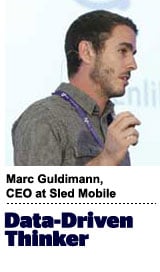 “Data-Driven Thinking” is written by members of the media community and contains fresh ideas on the digital revolution in media.
“Data-Driven Thinking” is written by members of the media community and contains fresh ideas on the digital revolution in media.
Today’s column is written by Marc Guldimann, CEO at Sled Mobile.
Viewability, the concept that advertising should be seen to be paid for, has taken the advertising industry by storm. It’s interesting to read the conclusions people draw about viewability: It is a currency, it might be a currency, it’s not ready to be a currency or will be a currency once standardized.
Most are directionally correct, but trying to classify viewability as a currency is a mistake. First, as a matter of semantics, a currency is what you transact with once a price for an amount of a good is established.
Here’s an easy way to think about it: When you fill up your tank with 10 gallons of 91 octane for $30, neither the gallons nor the octane are the currency – they are units of measurement of the good you are purchasing. The $30 is the only currency in this example.
It’s the same with the dollars on your media plan. Gallons, the metric of sale, is equivalent to impressions in digital advertising. When people lament about new currencies, they are really referring to new metrics of sale.
The metric of sale’s purpose is to represent the “amount of thing” contained within a single unit of a good. The amount of gasoline in a gallon is extremely consistent so it’s a great metric of sale.
Advertising’s “thing” is more nebulous, but at its core the advertising industry is about buying and selling attention, so it makes sense that the metric of sale for advertising should attempt to measure attention. Today display advertising uses the impression, but it does a poor job of yielding a consistent amount of attention. As a result, it’s no wonder that the industry is rushing to anoint new currencies metrics of sale.
The right question to ask is: “Is viewability the right way to measure attention?” Or, more specifically: “Does viewability give me enough information about how much attention is paid to an ad to transact on it?”
Time In View
The answer is that it’s getting close, but viewability doesn’t have the granularity required to be the pricing metric for a transaction in its own right. Instead, a derivative of viewability – time in view – has been cast into the spotlight as the savior of display advertising.
For example, there might be six viewable ads on a slideshow page where you spent three seconds, as well as one viewable ad on an article page where you spent four minutes reading. If today’s MRC standard for viewability were the measure of attention, all of those ads would be considered the same. Granted, viewability is an improvement over the vanilla impression metric, which has been widely used since the inception of the banner ad.
There are a couple of products trying to increase the resolution of viewability metrics by selling display ads based on seconds of viewability, also known as time in view. Buys are made with typical adjacent banner sizes in bucketed time increments.
Buying banners on a time-in-view metric solves for the value delta between two ads that were on screen for different amounts of time. It’s also an amazingly useful tool when measuring the impact of media but doesn’t address share of attention. There could still be eight ads in view at the same time, not to mention the attention paid to the content that the reader is there to consume in the first place. Without quantifying the amount of attention paid, it’s hard to transact on time in view.
Share Of Attention
Technological means can be used to quantify the amount of attention paid to an ad. Chartbeat, for example, measures attention in large part by tracking movement or interaction via a mouse, according to Gigaom.
There’s also eye tracking. Every phone has a camera that could be used to track eye movements. But sending a message to users along the lines of “The application ‘News App’ would like to access the location of your corneas” is sort of a big ask. Many consumers would object to this kind of default tracking, and the value exchange needed to drive opt-in at scale would be cost prohibitive. But with Google Glass v2 around the corner, you never know.
A simpler, albeit potentially less accurate, way to measure attention is to use interruptive ads. If an ad is interruptive, it captures 100% of attention paid to the medium while it’s in view. Interruption has worked for TV, radio, print, video, social feed and even Snapchat ads.
They aren’t perfect. There’s a very reasonable backlash against ads that break experiences in the name of capturing attention or driving performance at the expense of experience. Some interstitial ads have tiny close buttons, while others split the page and move content around. Others, like most pre-roll ads, force audiences to spend time with ads.
But the best interruptive ads, which I call “politely interruptive,” are built with an understanding of their environment and give readers control of how long they want to spend with the content. The amount of time an individual chooses to spend with a message may offer the granularity and specificity required to be a metric of sale.
Thirteen years ago, the digital direct-response advertising was revolutionized by the creation of a more accurate metric of sale: the click. Since more accurate metrics of sale mean less risk borne by the advertiser, direct-response advertisers have been able to deploy a disproportionate amount of capital digitally since then.
Now, measuring share of attention down to the cost per second could do for digital brand advertisers what CPC did for the direct-response industry: revolutionize it by removing buy-side risk.
Follow Marc Guldimann (@guldi), Sled Mobile (@sledmobile) and AdExchanger (@adexchanger) on Twitter.












